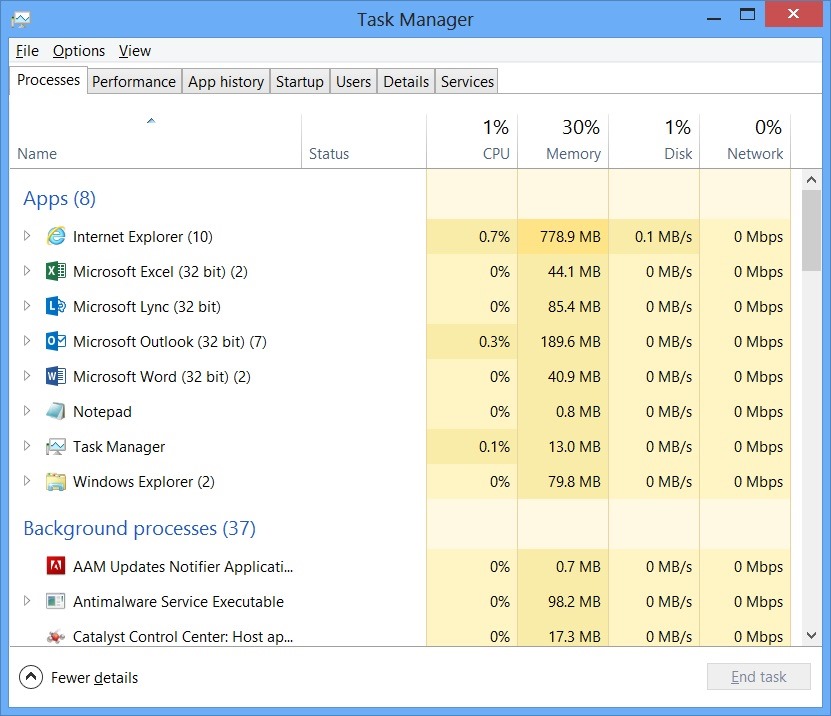
Task Manager in Windows 8 is a powerful tool that allows users to monitor and manage the performance of their system, troubleshoot issues, and control running processes and applications. Whether you need to identify resource-intensive tasks, terminate unresponsive programs, or analyze system performance, Task Manager provides the necessary tools and insights to help you maintain a smooth and efficient computing experience. In this comprehensive guide, we’ll explore everything you need to know about using Task Manager in Windows 8, from accessing it to leveraging its various features effectively.
Understanding Task Manager:
Task Manager is a system utility in Windows 8 that provides real-time information about running processes, performance metrics, and resource usage. It allows users to monitor system performance, manage running applications and processes, and troubleshoot issues that may arise. Here are some key features of Task Manager:
- Processes Tab: Displays a list of all currently running processes, including applications, background processes, and system services.
- Performance Tab: Provides real-time information about CPU, memory, disk, and network usage, allowing users to monitor system performance.
- App History Tab: Shows resource usage statistics for Windows Store apps over time, including CPU time, network usage, and metered network usage.
- Startup Tab: Allows users to manage startup programs and disable unnecessary programs from launching automatically when Windows starts.
- Users Tab: Displays information about active user sessions and allows administrators to log off users or manage user sessions.
Accessing Task Manager:
There are several ways to access Task Manager in Windows 8:
- Ctrl + Shift + Esc: Pressing this keyboard shortcut opens Task Manager directly.
- Ctrl + Alt + Delete: Pressing these keys together brings up a menu where you can select Task Manager.
- Right-Click Taskbar: Right-clicking on the taskbar and selecting “Task Manager” from the context menu also opens Task Manager.
Using Task Manager:
Once Task Manager is open, you can use its various tabs and features to monitor and manage your system effectively:
- Processes Tab:
- Identify resource-intensive processes by sorting the list by CPU, memory, disk, or network usage.
- Right-click on a process to end it, set priority, create a dump file, or navigate to its location in File Explorer.
- Performance Tab:
- Monitor system performance in real-time, including CPU usage, memory usage, disk activity, and network activity.
- Use the graphs and counters to identify bottlenecks or resource constraints.
- App History Tab:
- View resource usage statistics for Windows Store apps, including CPU time, network usage, and metered network usage.
- Identify apps that are consuming excessive resources or causing performance issues.
- Startup Tab:
- Manage startup programs and disable unnecessary programs from launching automatically when Windows starts.
- Right-click on a startup program to disable it or open its file location.
- Users Tab:
- View information about active user sessions, including username, session ID, and session status.
- Log off users or manage user sessions as needed.
Advanced Features:
Task Manager also includes some advanced features that can be accessed by clicking on “More details” at the bottom of the Task Manager window:
- Resource Monitor: Provides detailed information about system resource usage, including CPU, memory, disk, and network activity.
- Services: Allows users to view and manage system services, including starting, stopping, and restarting services.
- Performance Graphs: Displays historical performance graphs for CPU, memory, disk, and network usage over time.
- App History Details: Provides additional details about resource usage for Windows Store apps, including CPU usage, network usage, and metered network usage.
Tips for Effective Use:
- Regular Monitoring: Make it a habit to regularly monitor Task Manager to identify and address any performance issues or resource constraints.
- End Unresponsive Programs: If a program becomes unresponsive, use Task Manager to end the process and regain control of your system.
- Manage Startup Programs: Disable unnecessary startup programs to improve system boot time and reduce resource usage.
- Use Resource Monitor: Take advantage of Resource Monitor for more detailed information about system resource usage and performance.
Conclusion:
Task Manager is a versatile tool that provides valuable insights into system performance and resource usage in Windows 8. By mastering its various tabs and features, users can effectively monitor and manage their systems, troubleshoot issues, and optimize performance for a smooth and efficient computing experience. So, whether you’re a power user troubleshooting performance issues or a casual user monitoring system resources, Task Manager is an indispensable utility that can help you maintain a healthy and responsive system in Windows 8.